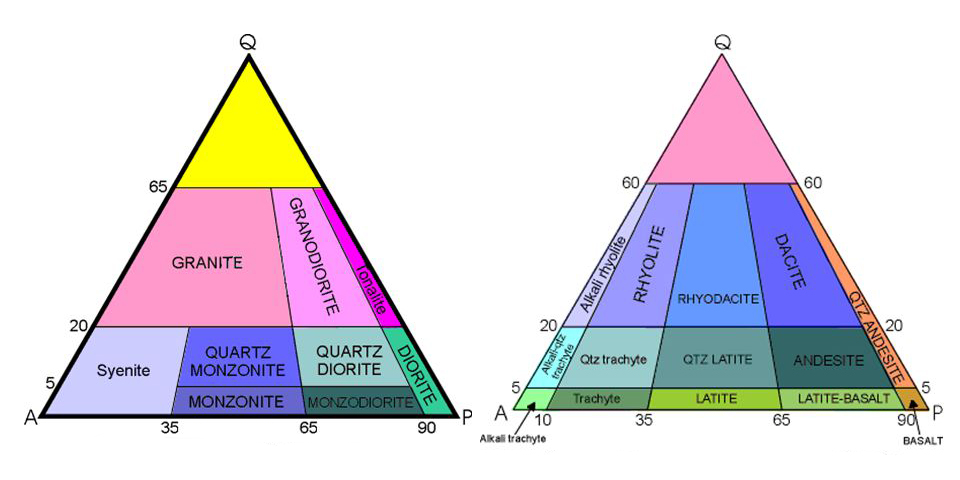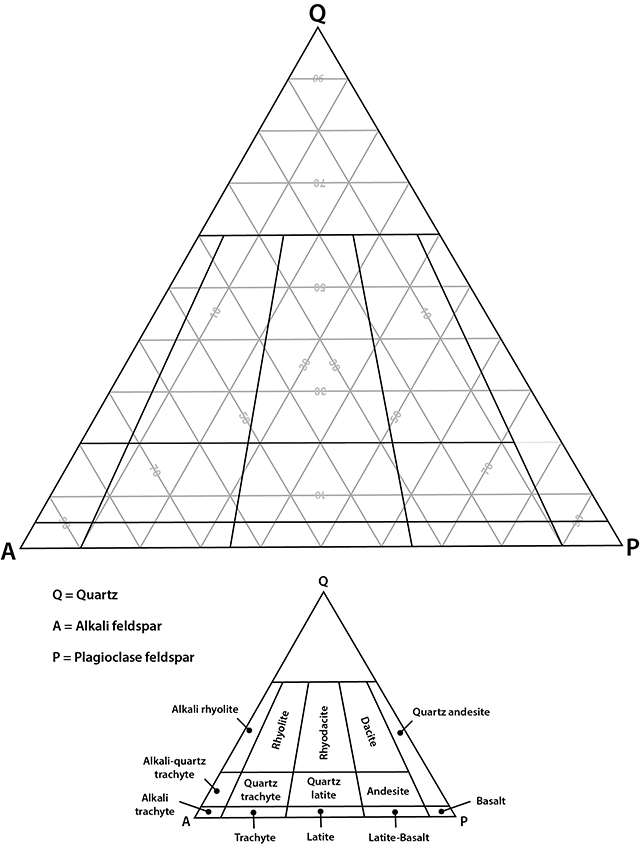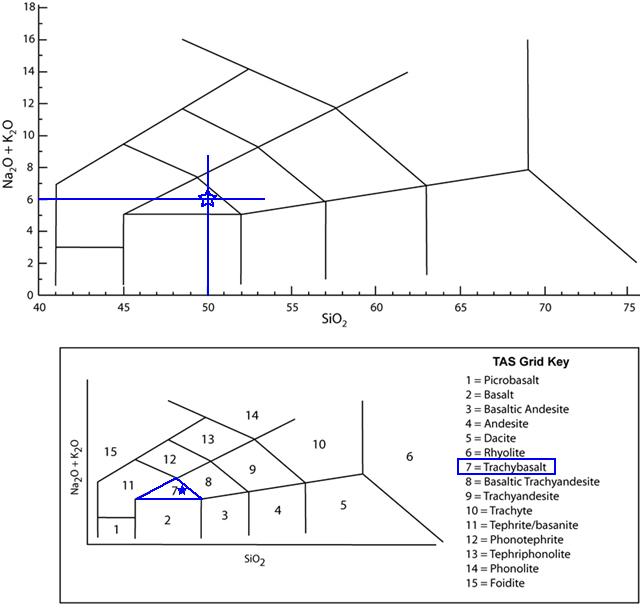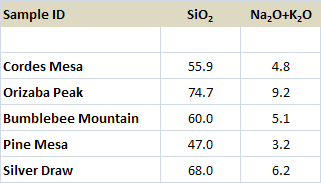Part B
Petrographic & Geochemical Classification of Volcanic Rocks
Field identification is the primary method used in describing and interpreting volcanic rocks. However, much more can be revealed about a rock's nature and origin with more quantitative petrographic and geochemical studies. In the previous lab, we named various coarse-grained plutonic rocks by using their mineralogy (a modal analysis - "point counting"). This same methodology can be applied to volcanic rocks, but due to the smaller crystal size, the modal analysis must be done using a microscope. Further geochemical analysis can yield information about the abundances of certain elements (like Si, Fe, Mg, etc.) and their oxides (like SiO2, FeO, MgO, etc.). This can be extremely helpful not only in classifying volcanic rocks, but in interpreting their origin as well.
Petrographic Classification
With the field classification, we use the overall color of a volcanic rock to estimate composition. This is quick and easy, but is rather qualitative and in some cases, may be misleading. To get around the color problem, we can describe the composition of volcanic rocks based on their actual mineralogy. As with plutonic rocks, modal analysis ("point-counting") can be performed on a volcanic rock to determine the percentages of minerals in the rock and accurately estimate its composition. The main difference is that since the mineral crystals are so small, point-counting in a volcanic rock is done at the microscopic level, looking at a thin section![]() with a petrographic microscope. This approach is commonly done by serious geologists who need a more quantitative estimate of rock composition. It requires sample preparation and expense, as well as time for the microscopic analysis, but it's fun!
with a petrographic microscope. This approach is commonly done by serious geologists who need a more quantitative estimate of rock composition. It requires sample preparation and expense, as well as time for the microscopic analysis, but it's fun!
If you recall our plutonic rock lab, we used mineralogy to name various rocks. A petrographic anaylsis for a given rock yielded three modal components, quartz (Q) + alkali feldspar (A) + plagioclase feldspar (P), which were then normalized to 100 percent and plotted on a ternary diagram. Well, the methodology is the same for volcanic rocks, except that the QAP ternary diagram is labeled with volcanic rock names (see Figure 6-6).
|
|
|
Figure 6-6. IUGS Igneous Rock Classification Diagram for plutonic rocks (left) and volcanic rocks (right). These classification diagrams are especially useful for felsic-intermediate rocks (ones with measurable amounts of quartz and alkali feldspar). |
|
|
|
Figure 6-7. Classification of volcanic rock names using the QAP ternary diagram. |
Use the QAP classification diagram in Figure 6-7 to answer Quiz Me! questions B21 through B25. If necessary, refer to the relevant module in Lab 05 that discusses how to plot data on ternarydiagrams.
![]()
![]()
![]()
![]()
![]()
Geochemical Classification
Geochemical analysis also provides a quantitative estimate of a rock's composition based on its geochemistry . Geochemical data is produced in various ways, but originally involves collection a fresh, representative rock sample. The composition of the whole rock or individual crystals can be analyzed. Various processing and analytical methods can then yield the relative abundances of various major elements (Si, O, Al, Fe, etc.), trace elements (Ni, Cr, Zr, etc.), and even isotopes (87Sr/86Sr, 207Pb/206Pb, etc.) that are used to describe and interpret the rock.
Major elements (e.g., O, Si, Al, Fe, Mg, etc.) are those that are present in the greatest relative abundance in a rock. Major elements combined with oxygen (called oxides) provide the fundamental basis for compositional description. The percentage (by weight) of oxides like SiO2, Na2O, K2O, MgO, etc., are used to describe, classify, and interpret compositions:
> Felsic - High SiO2 (>63 wt%), Al2O3, Na2O, K2O, etc., and low MgO, FeO, and CaO.
> Intermediate - SiO2 (52-63 wt%).
> Mafic - Low SiO2 (45-52 wt%), Al2O3, Na2O, K2O, etc., and high MgO, FeO, and CaO.
> Ultramafic - Very low SiO2 (<45 wt%) and very high MgO, FeO, and CaO.
Geochemical analysis yields abundant detail about rock composition, but like petrographic analysis, requires sample preparation and laboratory expense.
![]()
![]()
Total Alkali - Silica (TAS) Classification
The total alkali - silica (TAS) classification (see Figure 6-8) is a relatively simple scheme used to assign names to many types of volcanic rocks that have been chemically analyzed. It compares the abundances (in weight %) of the alkali oxides (Na2O+K2O) and silica (SiO2). The name of a volcanic rock can be determined after the proper oxide values are plotted on a binary diagram (2 component or X-Y diagram) labeled with different rock name fields. Before classifying rocks using the TAS diagram, the chemical analyses must be recalculated to 100%, excluding volatiles like water and carbon dioxide. The TAS classification should be used only if you can't easily identify the minerals in a rock and the mineral mode cannot be determined.
|
|
|
Figure 6-8. Total alkali versus silica diagram (Le Maitre and others, 2002; Le Bas and others, 1986). |
|
Example 1 |
|
Using the TAS diagram, name the volcanic rock that has 50.0 wt% SiO2 and 6.0 wt% Na2O + K2O. |
|
Trachybasalt |
|
|
|
Table 6-1. Geochemical sample data. |
Use the data in Table 6-1 to answer Quiz Me! questions B28 through B30.
![]()
![]()
![]()
Interpreting Weight % SiO2
Proper interpretation of geochemical data can also help describe the nature and origin of a volcanic rock. For example, determining the silica content (SiO2) of a volcanic rock can be important because it relates to the origin of the magma and how the magma erupts and flows.
Origin of the Magma - In general, SiO2-rich (felsic) magmas form from the melting of continental crust, whereas SiO2-poor (mafic) magmas form from partial melting of the mantle. Intermediate magmas form from the hydrous (water-rich) partial melting of oceanic and/or continental crust, mixing of mafic and felsic magmas, etc.
How Magma Erupts and Flows - The higher the wt% SiO2, the more viscous the magma . SiO2-rich (>63 wt%) lavas are highly viscous and form short, thick flows and steep-sided lava domes. Violent eruptions of these lavas can occur because of the pressure of the trapped gases. SiO2-poor (<52 wt% SiO2) lavas are very fluid and flow for longer distances. These lavas typically erupt more passively because the gas that drives an eruption escapes more easily.
Use the data in Table 6-1 and the in discussion above to answer questions B31 and B32.
![]()
![]()




